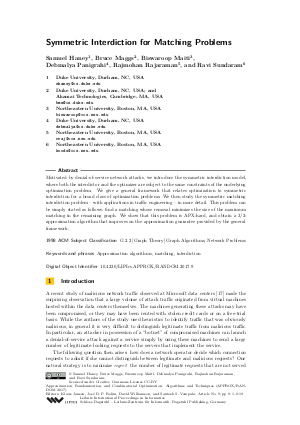Symmetric Interdiction for Matching Problems
Authors Samuel Haney, Bruce Maggs, Biswaroop Maiti, Debmalya Panigrahi, Rajmohan Rajaraman, Ravi Sundaram
-
Part of:
Volume:
Approximation, Randomization, and Combinatorial Optimization. Algorithms and Techniques (APPROX/RANDOM 2017)
Part of: Series: Leibniz International Proceedings in Informatics (LIPIcs)
Part of: Conference: International Conference on Randomization and Computation (RANDOM)
Part of: Conference: International Conference on Approximation Algorithms for Combinatorial Optimization Problems (APPROX) - License:
 Creative Commons Attribution 3.0 Unported license
Creative Commons Attribution 3.0 Unported license
- Publication Date: 2017-08-11
File

PDF
LIPIcs.APPROX-RANDOM.2017.9.pdf
- Filesize: 0.69 MB
- 19 pages
Document Identifiers
Subject Classification
Keywords
- Approximation algorithms
- matching
- interdiction Digital Object
Metrics
- Access Statistics
-
Total Accesses (updated on a weekly basis)
0PDF Downloads0Metadata Views
Abstract
Motivated by denial-of-service network attacks, we introduce the symmetric interdiction model, where both the interdictor and the optimizer are subject to the same constraints of the underlying optimization problem. We give a general framework that relates optimization to symmetric interdiction for a broad class of optimization problems. We then study the symmetric matching interdiction problem - with applications in traffic engineering - in more detail. This problem can be simply stated as follows: find a matching whose removal minimizes the size of the maximum matching in the remaining graph. We show that this problem is APX-hard, and obtain a 3/2-approximation algorithm that improves on the approximation guarantee provided by the general framework.
Cite As Get BibTex
Samuel Haney, Bruce Maggs, Biswaroop Maiti, Debmalya Panigrahi, Rajmohan Rajaraman, and Ravi Sundaram. Symmetric Interdiction for Matching Problems. In Approximation, Randomization, and Combinatorial Optimization. Algorithms and Techniques (APPROX/RANDOM 2017). Leibniz International Proceedings in Informatics (LIPIcs), Volume 81, pp. 9:1-9:19, Schloss Dagstuhl – Leibniz-Zentrum für Informatik (2017)
https://doi.org/10.4230/LIPIcs.APPROX-RANDOM.2017.9
BibTex
@InProceedings{haney_et_al:LIPIcs.APPROX-RANDOM.2017.9,
author = {Haney, Samuel and Maggs, Bruce and Maiti, Biswaroop and Panigrahi, Debmalya and Rajaraman, Rajmohan and Sundaram, Ravi},
title = {{Symmetric Interdiction for Matching Problems}},
booktitle = {Approximation, Randomization, and Combinatorial Optimization. Algorithms and Techniques (APPROX/RANDOM 2017)},
pages = {9:1--9:19},
series = {Leibniz International Proceedings in Informatics (LIPIcs)},
ISBN = {978-3-95977-044-6},
ISSN = {1868-8969},
year = {2017},
volume = {81},
editor = {Jansen, Klaus and Rolim, Jos\'{e} D. P. and Williamson, David P. and Vempala, Santosh S.},
publisher = {Schloss Dagstuhl -- Leibniz-Zentrum f{\"u}r Informatik},
address = {Dagstuhl, Germany},
URL = {https://drops.dagstuhl.de/entities/document/10.4230/LIPIcs.APPROX-RANDOM.2017.9},
URN = {urn:nbn:de:0030-drops-75587},
doi = {10.4230/LIPIcs.APPROX-RANDOM.2017.9},
annote = {Keywords: Approximation algorithms, matching, interdiction Digital Object}
}
Author Details
References
-
Douglas S. Altner, Özlem Ergun, and Nelson A. Uhan. The maximum flow network interdiction problem: valid inequalities, integrality gaps, and approximability. Operations Research Letters, 38(1):33-38, 2010.

-
Imre Bárány and Roman Karasev. Notes about the carathéodory number. Discrete &Computational Geometry, 48(3):783-792, 2012.

-
Piotr Berman and Marek Karpinski. On some tighter inapproximability results. In International Colloquium on Automata, Languages, and Programming, pages 200-209. Springer, 1999.

-
Stephen R. Chestnut and Rico Zenklusen. Interdicting structured combinatorial optimization problems with 0, 1-objectives. Mathematics of Operations Research, 2016.

-
Stephen R. Chestnut and Rico Zenklusen. Hardness and approximation for network flow interdiction. Networks, 2017.

-
Richard L. Church, Maria P. Scaparra, and Richard S. Middleton. Identifying critical infrastructure: the median and covering facility interdiction problems. Annals of the Association of American Geographers, 94(3):491-502, 2004.

-
Eugene Peter Durbin. An interdiction model of highway transportation. Rand Memorandum, 1966.

-
Greg N. Frederickson and Roberto Solis-Oba. Increasing the weight of minimum spanning trees. Journal of Algorithms, 33(2):244-266, 1999.

-
P. M. Ghare, Douglas C. Montgomery, and W. C. Turner. Optimal interdiction policy for a flow network. Naval Research Logistics Quarterly, 18(1):37-45, 1971.

-
Bruce Golden. A problem in network interdiction. Naval Research Logistics Quarterly, 25(4):711-713, 1978.

-
Martin Grötschel, Lászlo Lovász, and Alexander Schrijver. Geometric Algorithms and Combinatorial Optimization, volume 2 of Algorithms and Combinatorics. Springer, second corrected edition edition, 1993.

-
Alpár Jüttner. On budgeted optimization problems. SIAM Journal on Discrete Mathematics, 20(4):880-892, 2006.

-
Rafael R. Kamalian and Vahan V. Mkrtchyan. Two polynomial algorithms for special maximum matching constructing in trees. arXiv preprint arXiv:0707.2295, 2007.

-
Rafael R. Kamalian and Vahan V. Mkrtchyan. On complexity of special maximum matchings constructing. Discrete Mathematics, 308(10):1792-1800, 2008.

-
Leonid Khachiyan, Endre Boros, Konrad Borys, Khaled Elbassioni, Vladimir Gurvich, Gabor Rudolf, and Jihui Zhao. On short paths interdiction problems: Total and node-wise limited interdiction. Theory of Computing Systems, 43(2):204-233, 2008.

-
Churlzu Lim and J. Cole Smith. Algorithms for discrete and continuous multicommodity flow network interdiction problems. IIE Transactions, 39(1):15-26, 2007.

-
Rui Miao, Rahul Potharaju, Minlan Yu, and Navendu Jain. The Dark menace: Characterizing network-based attacks in the cloud. In Proceedings of the 2015 ACM Internet Measurement Conference, 2015.

- Manfred W. Padberg and M. R. Rao. Odd minimum cut-sets and b-matchings. Mathematics of Operations Research, 7(1):67-80, 1982. URL: http://dx.doi.org/10.1287/moor.7.1.67.
-
Jörg Rambau. On a generalization of schönhardt’s polyhedron. Combinatorial and computational geometry, 52:510-516, 2003.

-
Alexander Schrijver. On the history of the transportation and maximum flow problems. Mathematical Programming, 91(3):437-445, 2002.

- Alexander Schrijver. Combinatorial optimization: polyhedra and efficiency. Vol. A. Paths, flows, matchings. Chapters 1-38. Algorithms and combinatorics. Springer-Verlag, 2003. URL: http://opac.inria.fr/record=b1100334.
-
F Bruce Shepherd and Adrian Vetta. The demand-matching problem. Mathematics of Operations Research, 32(3):563-578, 2007.

-
Adrian Vetta and Gwenaël Joret. Reducing the rank of a matroid. Discrete Mathematics &Theoretical Computer Science, 17, 2015.

-
Heinrich Von Stackelberg. Market structure and equilibrium. Springer Science &Business Media, 2010.

-
R. Kevin Wood. Deterministic network interdiction. Mathematical and Computer Modelling, 17(2):1-18, 1993.

-
Rico Zenklusen. Matching interdiction. Discrete Applied Mathematics, 158(15):1676-1690, 2010.

-
Rico Zenklusen. Network flow interdiction on planar graphs. Discrete Applied Mathematics, 158(13):1441-1455, 2010.

-
Rico Zenklusen. An o(1)-approximation for minimum spanning tree interdiction. In Foundations of Computer Science (FOCS), 2015 IEEE 56th Annual Symposium on, pages 709-728. IEEE, 2015.

